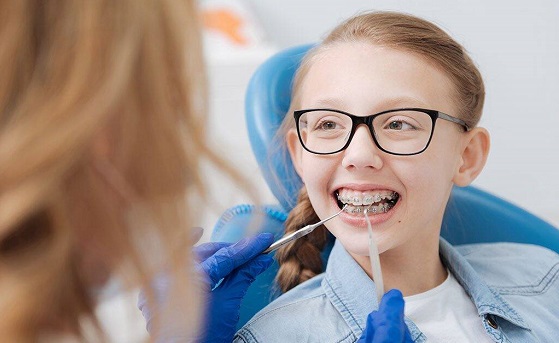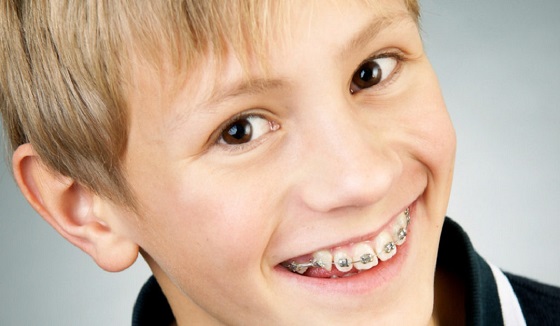A few children can hardly wait to get their braces, considering them to be an indication that their youngster years can’t be a long ways behind. Others, however, stress over what they’ll feel or resemble.
Anyway your kid feels, you likely have a few inquiries and worries of your own about braces(counting how you’re going to pay for them!). Here’s the lowdown on children and braces.
Why Kids Need Braces

Children can require preparation for quite a few reasons, including abnormal, covering, or packed teeth, or a “terrible nibble” (known as malocclusion).
Malocclusion is the point at which there’s a distinction in the spans of the top and base jaws. At the point when the upper jaw is greater than the lower jaw, it’s called an overbite. At the point when the lower jaw is greater, it’s called an underbite.
Now and again tooth and jaw issues can be brought about by losing child teeth too early, mishaps, or propensities like thumb sucking. In any case, regularly they’re acquired, so in the event that you or somebody in your family requires braces, almost certainly, your children will, as well.
Frequently, your kid’s dental specialist will be the first to see issues during a customary visit and suggest that you see an orthodontist (a dental specialist who works in rectifying jaw as well as teeth arrangement issues). The orthodontist can choose whether your youngster does undoubtedly require dental braces and which gadgets would be ideal.
There’s no set age for a youngster’s first orthodontist visit – a few children go when they’re 6, a few children go when they’re 10, and some go while they’re teenagers. Indeed, even grown-ups can require orthodontic treatment. Numerous orthodontists state children should see an orthodontist once their perpetual teeth begin coming in, around age 7.
At this age, issues, for example, lopsided chomp and congestion will get obvious.
Beginning the cycle early doesn’t mean a youngster will get braces immediately. It just methods the orthodontist will have the option to discover issues and choose the best and ideal opportunity to begin treatment.
The First Orthodontist Visit

At the primary visit, the orthodontist will completely look at your kid’s teeth, mouth, and jaw. The person may request that your kid nibble the teeth together and may likewise pose inquiries about whether your kid has issues biting or gulping, or has ever had clicking or flying of the jaw.
The orthodontist may take X-rays of the mouth and teeth to perceive how the teeth are situated and whether any perpetual teeth despite everything need to come in. The individual in question additionally may make a shape (or impression) of your kid’s teeth by squeezing a plate of gooey material into the top and base teeth.
At the point when the shape is eliminated and the material solidifies, the outcome is a reproduction of your kid’s teeth that will permit the orthodontist to choose which treatment alternatives are ideal.
Sort of dental Braces
braces right arrangement issues by squeezing the teeth, which in the end moves them into a straighter position.
Most children simply need braces with sections, wires, and elastic groups. The sections append to the teeth and are associated by a wire and elastic groups. The wire is fixed a little bit at a time after some time to gradually help line the teeth up appropriately.
The elastic groups come for no particular reason hues that children can pick. Despite the fact that metal braces are as yet utilized, so are clear or white fired braces, which are substantially less observable. Some even go behind the teeth (lingual braces).
Clear removable braces that move teeth with plastic plates called aligners (as opposed to wires and elastic groups) are additionally accessible, however these are just ideal for certain individuals.
A few children may require different gadgets, as well, for example, headgear (don’t stress – this is normally worn uniquely around evening time!). Headgear utilizes a horseshoe-molded wire that appends to the back teeth, giving more grounded power to move the teeth. The orthodontist additionally may suggest that your kid have at least one teeth eliminated to make more space in their mouth.
When the braces are on, your youngster should visit the orthodontist at regular intervals for observing and changes.
How long your youngster should wear braces relies upon the issues the orthodontist is attempting to fix, however the normal is around 2 years.
From that point forward, your kid may wear an extraordinarily formed retainer – a little, hard bit of plastic with metal wires or a slight bit of plastic molded like a mouthguard. Retainers shield the teeth from meandering back to their unique spots.
Thinking about Braces

Since it’s so natural for food to stall out in wired braces, kids who wear them have to make a solid effort to keep their teeth clean. Brushing after suppers is basic, as is day by day flossing (the orthodontist can give your kid a unique flosser to use in and around braces). Ordinary dental cleanings and exams to search for cavities are likewise an unquestionable requirement.
Your kid ought to dodge certain nourishments, (for example, popcorn, hard and clingy candy, and gum) since they can harm braces. Sweet soft drinks and squeezes can be an issue, as well, since they can add to tooth rot. Children with clear plastic aligners ought to consistently eliminate them when it’s an ideal opportunity to eat.
Since braces put focus on the teeth, they can feel awkward every so often, particularly after the orthodontist makes modifications. Assuming control over-the-counter agony relievers and eating delicate nourishments can help if this occurs.
See the orthodontist immediately if your youngster has a free wire or section, or a wire that is jabbing their mouth. In the event that the orthodontist can’t discover an issue, your youngster may utilize some delicate orthodontic wax to cover any sharp spots on the braces that are annoying or scouring against within the mouth or gums.
Expert opinion
- Dr. Ankita Gada Children with orthodontic issues can benefit from treatment at almost any age."





